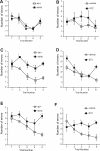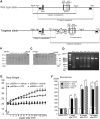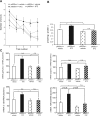p66Shc Signaling Mediates Diabetes-Related Cognitive Decline
- PMID: 29453337
- PMCID: PMC5816624
- DOI: 10.1038/s41598-018-21426-6
p66Shc Signaling Mediates Diabetes-Related Cognitive Decline
Abstract
Accumlating evidence have suggested that diabetes mellitus links dementia, notably of Alzheimer's disease (AD). However, the underlying mechanism remains unclear. Several studies have shown oxidative stress (OS) to be one of the major factors in the pathogenesis of diabetic complications. Here we show OS involvement in brain damage in a diabetic animal model that is at least partially mediated through an AD-pathology-independent mechanism apart from amyloid-β accumulation. We investigated the contribution of the p66Shc signaling pathway to diabetes-related cognitive decline using p66Shc knockout (-/-) mice. p66Shc (-/-) mice have less OS in the brain and are resistant to diabetes-induced brain damage. Moreover, p66Shc (-/-) diabetic mice show significantly less cognitive dysfunction and decreased levels of OS and the numbers of microglia. This study postulates a p66Shc-mediated inflammatory cascade leading to OS as a causative pathogenic mechanism in diabetes-associated cognitive impairment that is at least partially mediated through an AD-pathology-independent mechanism.
Conflict of interest statement
The authors declare no competing interests.
Figures







Similar articles
-
Inhibition of S-Adenosylhomocysteine Hydrolase Induces Endothelial Dysfunction via Epigenetic Regulation of p66shc-Mediated Oxidative Stress Pathway.Circulation. 2019 May 7;139(19):2260-2277. doi: 10.1161/CIRCULATIONAHA.118.036336. Circulation. 2019. PMID: 30773021
-
Diabetes-Associated Myelopoiesis Drives Stem Cell Mobilopathy Through an OSM-p66Shc Signaling Pathway.Diabetes. 2019 Jun;68(6):1303-1314. doi: 10.2337/db19-0080. Epub 2019 Apr 1. Diabetes. 2019. PMID: 30936144
-
Sirtuin1-regulated lysine acetylation of p66Shc governs diabetes-induced vascular oxidative stress and endothelial dysfunction.Proc Natl Acad Sci U S A. 2017 Feb 14;114(7):1714-1719. doi: 10.1073/pnas.1614112114. Epub 2017 Jan 30. Proc Natl Acad Sci U S A. 2017. PMID: 28137876 Free PMC article.
-
Role of adaptor protein p66Shc in renal pathologies.Am J Physiol Renal Physiol. 2018 Feb 1;314(2):F143-F153. doi: 10.1152/ajprenal.00414.2017. Epub 2017 Oct 4. Am J Physiol Renal Physiol. 2018. PMID: 28978535 Free PMC article. Review.
-
P66Shc and vascular endothelial function.Biosci Rep. 2019 Apr 30;39(4):BSR20182134. doi: 10.1042/BSR20182134. Print 2019 Apr 30. Biosci Rep. 2019. PMID: 30918103 Free PMC article. Review.
Cited by
-
The Role of p66Shc in Diabetes: A Comprehensive Review from Bench to Bedside.J Diabetes Res. 2022 Nov 24;2022:7703520. doi: 10.1155/2022/7703520. eCollection 2022. J Diabetes Res. 2022. PMID: 36465704 Free PMC article. Review.
-
p66Shc activation promotes increased oxidative phosphorylation and renders CNS cells more vulnerable to amyloid beta toxicity.Sci Rep. 2018 Nov 20;8(1):17081. doi: 10.1038/s41598-018-35114-y. Sci Rep. 2018. PMID: 30459314 Free PMC article. Review.
-
Hyperglycemic stress induces oxidative damage of enteric glial cells by triggering redoxosomes/p66SHC activation.Redox Rep. 2024 Dec;29(1):2324234. doi: 10.1080/13510002.2024.2324234. Epub 2024 Mar 5. Redox Rep. 2024. PMID: 38444386 Free PMC article.
-
The role of intermittent fasting in the treatment of cognitive dysfunction in type 2 diabetes mellitus.Front Nutr. 2025 May 9;12:1603165. doi: 10.3389/fnut.2025.1603165. eCollection 2025. Front Nutr. 2025. PMID: 40416375 Free PMC article. No abstract available.
-
The oDGal Mouse: A Novel, Physiologically Relevant Rodent Model of Sporadic Alzheimer's Disease.Int J Mol Sci. 2023 Apr 9;24(8):6953. doi: 10.3390/ijms24086953. Int J Mol Sci. 2023. PMID: 37108119 Free PMC article.
References
Publication types
MeSH terms
Substances
LinkOut - more resources
Full Text Sources
Other Literature Sources
Molecular Biology Databases

